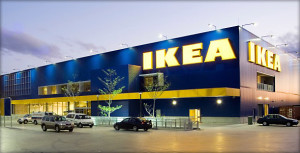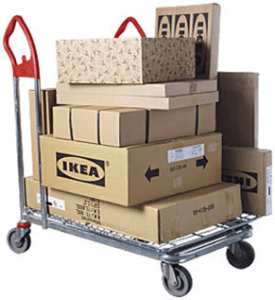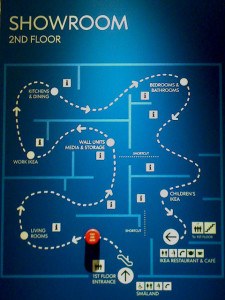The IKEA Concept: More than just a good meatball

As students, I’m sure most of us are familiar with the surprisingly affordable, yet frustratingly complicated, Ikea furniture. But for those who may not
know, Ikea is a Swedish home furnishing company known for their broad range of products at affordable prices (an d delicious meatballs). Ikea prides itself on its unique designs which combine function, quality, and value in all steps of the manufacturing and delivery process. Ikea is able to support its business model through its operations by including low cost design in all aspects of its supply chain, its organizational focus on delivering core capabilities, and its ability to get retail shoppers back to brick and mortar stores.
d delicious meatballs). Ikea prides itself on its unique designs which combine function, quality, and value in all steps of the manufacturing and delivery process. Ikea is able to support its business model through its operations by including low cost design in all aspects of its supply chain, its organizational focus on delivering core capabilities, and its ability to get retail shoppers back to brick and mortar stores.
Together we save money
Ikea believes that good designs should be available “for the many, not the few.” [1] To do this, Ikea decides on the price tag first, then develops functional products to meet that price point. This practice motivates Ikea engineers to find innovative design solutions to keep costs down while still offering a broad range of products that people need. Another manufacturing advantage for Ikea is its extreme size; as the world’s largest furniture retailer, they have incredible buying power which allows them to use low cost materials.
 Ikea engineers have also expertly designed product packaging. For example, “flat packs” were invited by an Ikea product designer in 1956. [1] When Gillis Lundgren attempted to pack the LOVET side table into his car, he had to saw the legs off to get it to fit. He then invented the flat pack which dramatically cut shipping and storage costs while improving the ease of transportation. Additionally, Ikea’s assemble-it-yourself policy drives costs down; in a way Ikea has been using its own customers as free laborers. Through these types of innovations and cost saving techniques, Ikea has kept pricing inexpensive without seeming cheap.
Ikea engineers have also expertly designed product packaging. For example, “flat packs” were invited by an Ikea product designer in 1956. [1] When Gillis Lundgren attempted to pack the LOVET side table into his car, he had to saw the legs off to get it to fit. He then invented the flat pack which dramatically cut shipping and storage costs while improving the ease of transportation. Additionally, Ikea’s assemble-it-yourself policy drives costs down; in a way Ikea has been using its own customers as free laborers. Through these types of innovations and cost saving techniques, Ikea has kept pricing inexpensive without seeming cheap.

Align on capabilities that matter most
Great companies are able to identify the most important capabilities that will support their operating and business models. Every company can’t be great at everything, so honing in on the distinct capabilities that are right for that particular business allows for more efficient spending and better results. At Ikea, they have focused on four primary capabilities for their cost leadership strategy. [2] Ikea has clearly linked their business unit strategies to low pricing, which motivates management to make decisions based on customer price. Additionally, Ikea’s clear focus on supplier relations translates into better pricing and higher in-stock levels. To make this capability a reality, Ikea located many of their procurement teams closer to their strategic suppliers to improve relationships and meet supplier goals.

Retail stores, more than just meatballs!
 As digital shopping becomes ever more popular, it is incredibly important to draw customers into existing retail stores. Ikea stores are much more than a retail space, they are an entertaining experience. The maze-like layout ensures you see all of their product offerings (many items are displayed multiple times throughout the showroom) while going on a fun adventure. [3] The food court and the kid’s playroom make shopping as a family much more accommodating and influences families to choose shopping at Ikea over other retailers. [4]
As digital shopping becomes ever more popular, it is incredibly important to draw customers into existing retail stores. Ikea stores are much more than a retail space, they are an entertaining experience. The maze-like layout ensures you see all of their product offerings (many items are displayed multiple times throughout the showroom) while going on a fun adventure. [3] The food court and the kid’s playroom make shopping as a family much more accommodating and influences families to choose shopping at Ikea over other retailers. [4]
By making retail shopping a fun experience, Ikea is able to justify the high fixed cost locations by bringing a high volume of people through the doors. In fact, even as the economic downturn was hitting retail hard, Ikea chose to continue investing in their retail stores. Ikea wants people to “feel at home” in their stores and uses this philosophy to deign their stores in a welcoming manner. [4] Most recently, Ikea has been testing smaller stores in city locations under a “click and collect” model. They believe customers will buy online and pickup their orders in these smaller retail locations. Ikea is using these test locations to “find out more about how customers want to shop with Ikea in these areas.” [5] By better understanding how their customers choose to interact with their websites and retail stores, Ikea will be better able to serve and support their consumers.
Ikea is able to expertly support its business model through its operations by executing a low cost model throughout its supply chain practices, by focusing on the right set of core capabilities, and by continuing to invest in their retail space. Affordable prices, modern designs, and hot meatballs, what more could you ask for?
Links
[1] http://www.ikea.com/ms/en_US/this-is-ikea/the-ikea-concept/
[4] http://www.forbes.com/sites/deniselyohn/2015/06/10/how-ikea-designs-its-brand-success/
[5] http://money.cnn.com/2015/11/17/news/companies/ikea-store-london-click-and-collect/



Great post Jessica!
One thing I have noticed over my years of shopping at Ikea is the constant use of the same screws/nuts/bolts/nails etc and tools in all of the furniture I have purchased. From a dresser to a desk to a bookshelf – it is the same small nails, same nut and bolt combinations, and that same weird L shaped tool to connect it all. In addition to your comment regarding economies of scale on the vast size of Ikea worldwide and the engineers’ attention to low cost, I would be curious to know just how much savings comes out of utilizing the same hardware over and over across numerous designs rather than making each unique.
Obviously keeping the hardware similar and simple makes the below linked photo of the Missing Parts available at Ikea that much more possible!
https://farm5.static.flickr.com/4146/4989858846_64864ecdfd.jpg
I’m curious how IKEA’s desire to learn more about its customers through the “click and collect” model aligns with their current operations. Whatever cost savings are realized by the procurement teams being located close to suppliers are probably countered, at least in part, by the need to deliver smaller, more frequent shipments from their distribution center(s) to these smaller locations. Since they’re still in the learning phase for these locations, local customer preferences are likely not fully understood, which could translate into over/under-stocking of certain SKUs. Just, as you say, IKEA uses its customers as free labor, they are also using customers as a free delivery service. The “click and collect” location in Norwich charges its customers up to £10 to pick up their own orders, perhaps in an attempt to recover some of the added costs incurred by the extension of their supply chain to these locations.
http://www.edp24.co.uk/news/shoppers_will_be_charged_up_to_10_to_collect_goods_from_ikea_store_in_norwich_1_4288659